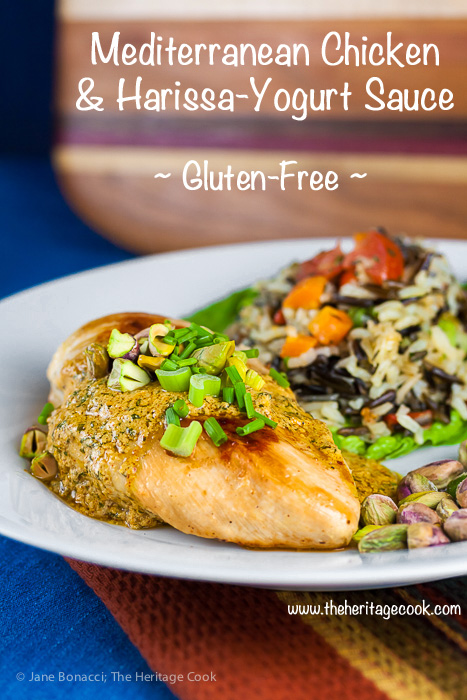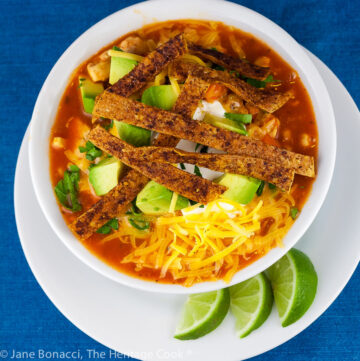If you are anything like me, you are always looking for new ways to prepare chicken. I tend to fall back to my comfort zone, repeating similar flavors and techniques over and over. One of the things I like the most about developing recipes for clients is that it forces me to think outside my normal boundaries, challenging myself to come up with new and creative ways to make meals.
Gourmet Garden’s herbs and seasonings make being creative easy. I pull them out and suddenly ideas race through my mind. There are so many ways to combine them. This month I wondered what I could make with oregano, garlic, parsley and cilantro? These are flavors often found in Mediterranean dishes and I wanted to find a new-to-me way of combining them.
I used the oregano when cooking the chicken, the cilantro and garlic in my homemade harissa, and parsley and garlic in the yogurt sauce. It was just the right combination of flavors to really enhance the chicken and make it something special.
When you think of hot sauce, you probably envision bottles of Tabasco or Sriracha. Those and hundreds of others are readily available on grocery store shelves across America. But in the countries of North Africa, their condiment of choice is harissa.
Harissa is a spicy chile-garlic paste found in many North African cuisines. It is used as rub or marinade before cooking, and as a condiment to add brightness to a wide variety of foods. In its original form it is scalding, but by making your own you can control the heat level. For The Artist and me, a medium heat level is perfect so I chose to make our with chipotle and New Mexican chiles. I love the smoky heat chipotles add – almost as if you had used the grill to cook the chicken.

The beautiful colors of pistachios
In this recipe the heat of the harissa is balanced by blending it with yogurt. In addition to this recipe, you can use the harissa mixture to season any meat, toss it with vegetables, use it as a spread on sandwiches, or as the base for crostini appetizers.
I was in a hurry to get dinner on the table (The Artist kept asking when it would be ready) and didn’t pull out my food processor, but I definitely will next time. I didn’t get as smooth a paste as I wanted and the final sauce was a bit broken instead of silky. The flavor was wonderful, but for the most attractive presentation, pureeing the chiles and sauce ingredients is the way to go.
When you are looking for a new way to use chicken, try this recipe. I’m sure your family will be intrigued by the history and exotic flavors. I know we were! 🙂
Have a wonderful weekend and we’ll see you on Chocolate Monday for another terrific treat!
Jane’s Tips and Hints:
A food processor or blender is the right tool to puree the sauce to its silky best. You can make the harissa paste and the harissa-yogurt sauce a day ahead to speed up the preparation time of this meal. With those already made, you can pull this together in less than 30 minutes. And if you have time, letting the chicken sit in a brine will help keep it moist during cooking – you could even add a little of the harissa to the brine to further flavor it!
Gluten-Free Tips:
This is an easy recipe to make gluten-free. Most of the ingredients are naturally safe and you only have to be careful on a couple of them. If you buy prepared harissa sauce, check the label carefully. Due to multiple allergies, I make my own and like that I can dial the heat level up or down to suit our tastes.


- Harissa-Yogurt Sauce
- 3 tsp Homemade Smoky Harissa (recipe follows) or prepared harissa paste
- 1 cup unflavored Greek yogurt
- 2 tsp Gourmet Gourmet Garden Lightly Dried Parsley
- 1 tsp Gourmet Garden Garlic paste
- Grated zest of 1 small orange or 2 tangerines
- Grated zest of 1/2 lemon
- 1 tbsp organic extra virgin olive oil
- 1 tsp kosher or fine sea salt, or to taste
- 1/4 tsp freshly ground black pepper
- Chicken
- 1/4 cup low-sodium chicken broth (gluten-free if needed)
- 1 tsp Gourmet Garden Oregano paste
- 4 boneless skinless chicken breast halves
- 1 tbsp organic olive oil
- 1 tbsp butter
- 1 tsp kosher salt
- 1/2 tsp freshly ground black pepper
- Garnish
- Drizzle of organic olive oil
- About 1 cup coarsely chopped salted pistachios
- Chopped chives and/or green onions, optional
- Make the Harissa-Yogurt Sauce: If needed, make the harissa paste from the recipe below. In the bowl of a food processor or mixing bowl, combine the sauce ingredients. Whisk until smooth. Set aside to blend flavors for at least 15 minutes or in the refrigerator up to overnight. Taste and adjust seasonings as desired. Refrigerate, covered, if not serving immediately.
- Prepare Chicken: In a small bowl, whisk together the chicken broth and oregano; set aside.
- In a 12-inch skillet, heat the oil and butter over medium-high heat. When the butter is melted and the oil is bubbling, add the chicken pieces, top side down. Cook without moving for about 3 to 5 minutes or until golden brown. Use tongs to flip the chicken, pour in the seasoned broth and cook the second side until an instant read thermometer inserted in the center registers 155°F to 160°F. Remove the chicken from the pan and set on a plate; tent with foil and let rest about 3 to 5 minutes.
- Finish Sauce: Remove the skillet from the heat and spoon out all but about 1 tbsp of the fat. Slowly add the Harissa-Yogurt sauce to the pan, scraping the bottom of the pan to loosen the browned bits - pure flavor! Whisk until lightly warmed and pan juices have been incorporated. There is plenty of residual heat in the pan to warm it through. Taste and adjust the seasonings as desired. If the sauce is too tart, add a pinch of sugar
- To Serve: Place cooked chicken on each warmed plate. Spoon some of the sauce over the each serving and sprinkle the top with the pistachios and parsley.


- 3 dried chipotle chiles
- 5 dried New Mexico chiles
- 2 tbsp Gourmet Garden Lightly Dried Cilantro
- 1/2 tsp ground cumin
- 1/4 tsp ground coriander
- 5 fresh mint leaves, finely chopped
- 3 tbsp organic olive oil, plus more as needed
- 1-1/2 tsp kosher salt
- 1 to 2 tsp Gourmet Garden Garlic Paste
- 1 tsp fresh lemon zest
- Juice of 1/2 lemon
- Prepare the Chiles: Cut the stems off and pull out the seeds. Cut lengthwise and press open. Scrape out any remaining seeds. Discard stems and seeds. Cut chiles into large chunks (scissors work well) and place in a heatproof bowl. Cover with boiling water and set aside to soak for 30 minutes or until softened.
- Make the Harissa: Drain the chiles, discarding the water. Place chiles in the bowl of a food processor. Add the cilantro, cumin, mint and oil. Pulse several times and then turn the machine on to fully puree the mixture. Stop occasionally to scrape down the sides. Process until completely smooth. Add the salt, garlic, lemon zest and juice. Process until smooth. Taste and adjust seasonings as desired.
- Transfer the paste to a sterilized 2-cup canning jar, compressing it slightly and smoothing the top. Pour in enough olive oil to completely cover by about 1/2-inch. This will help preserve the harissa.
- Cover and refrigerate, adding more oil after each use so that the top is always protected. Harissa paste will hold up to 3 weeks in the refrigerator.
Create a New Tradition Today!
Disclosure: This is a sponsored post. I received compensation and products for recipe development.
Let’s connect! If you ever need any entertaining or cooking advice, need to alter a recipe for gluten-free, or want recipe suggestions, don’t hesitate to contact me. Thanks for reading!
Unauthorized use, distribution, and/or duplication of proprietary material from The Heritage Cook without prior approval is prohibited. This includes copying and reprinting content and photographs. If you have any questions or would like permission, I can be contacted via email. Feel free to quote me, just give credit where credit is due, link to the recipe, and please send people to my website, www.theheritagecook.com. Please see the Disclaimers page for additional details.
This site is not intended to provide medical advice. The suggestions here are not intended as dietary advice or as a substitute for consulting a dietician, physician, or other medical professional. It is the reader’s sole responsibility to determine which foods are appropriate and safe for their family to consume. Always consult your doctor. The author makes no claims regarding the presence of food allergens and disclaims all liability in connection with the use of this site.
Thank You!











